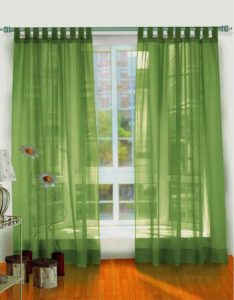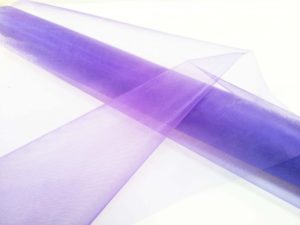 Organza is an amazing material that combines mysterious transparency, airiness and lightness, the luxury of the East and discreet European elegance. It can be shiny or matte, smooth or with workmanship (laser cutting, figured perforation, embroidery, designs applied by various methods, gold or silver plating, woven metallized threads). But the main feature is the same - the iridescent shining color.
Organza is an amazing material that combines mysterious transparency, airiness and lightness, the luxury of the East and discreet European elegance. It can be shiny or matte, smooth or with workmanship (laser cutting, figured perforation, embroidery, designs applied by various methods, gold or silver plating, woven metallized threads). But the main feature is the same - the iridescent shining color.
 Organza appeared in Europe in the 13th century. Despite the fact that the history of the fabric goes back more than two centuries, little is known about its origin. There is still debate about the etymology of the name. Some researchers claim that it was given in honor of the city of Urgench (Uzbekistan), where the production of natural silk was widely developed. Others are sure that the name came from the Loganza brand (USA), which was also involved in the production and sale of natural silk in the mid-19th century.
Organza appeared in Europe in the 13th century. Despite the fact that the history of the fabric goes back more than two centuries, little is known about its origin. There is still debate about the etymology of the name. Some researchers claim that it was given in honor of the city of Urgench (Uzbekistan), where the production of natural silk was widely developed. Others are sure that the name came from the Loganza brand (USA), which was also involved in the production and sale of natural silk in the mid-19th century.
Initially, the fabric was made from silk threads twisted in a special way.They were so thin that they looked transparent. The fabric was very expensive because it was very difficult to obtain natural fiber without flaws. Only wealthy fashionistas could afford such luxury. Later, viscose and other synthetic materials began to be used, which led to a decrease in cost. Modern organza consists entirely of polyester, but the quality characteristics have not deteriorated.
The material has a number of distinctive features, most of which are positive:
There are significantly fewer disadvantages:
 The fabric is ideal for sewing light curtains and creating modern window designs. It is stiffer and denser than ordinary tulle; its service life without deterioration in appearance and other performance characteristics is 8–10 years. Goes well with all fabrics used to make heavy blackout curtains.With high density and rigidity, it has excellent light transmission. It is resistant to fading and can be hung on windows facing south. Dust does not accumulate on the fabric fibers for a long time, and monthly washing is not required.
The fabric is ideal for sewing light curtains and creating modern window designs. It is stiffer and denser than ordinary tulle; its service life without deterioration in appearance and other performance characteristics is 8–10 years. Goes well with all fabrics used to make heavy blackout curtains.With high density and rigidity, it has excellent light transmission. It is resistant to fading and can be hung on windows facing south. Dust does not accumulate on the fabric fibers for a long time, and monthly washing is not required.
Organza curtains will be a win-win in any interior, especially if you use natural shades (green, ocher, gold, yellow, blue). A special charm is created by the combination of two colors. When using white curtains in a room with white walls, the shade match must be 100%, otherwise the darker color will look dirty.
Smooth iridescent organza fits well into ethnic and eclectic interiors. Matte is suitable for classic and high-tech styles, as it reflects less light. Fabric with embroidery is used for interiors in a romantic style and Provence. Large patterns look better on panoramic windows and in large rooms. For small windows it is better to choose natural organza; polyester does not form small folds well.
Organza for curtains comes in several types:
 This is a beautiful, durable translucent fabric, often used by designers to create interiors in different styles.It is obtained as a result of flocking - a complex technological operation that involves applying chemically treated textile fibers to fabric to create beautiful embossed patterns that are velvety to the touch. Flock fibers can vary in thickness, color and length.
This is a beautiful, durable translucent fabric, often used by designers to create interiors in different styles.It is obtained as a result of flocking - a complex technological operation that involves applying chemically treated textile fibers to fabric to create beautiful embossed patterns that are velvety to the touch. Flock fibers can vary in thickness, color and length.
Most often, this fabric is used for window design. Flocking allows you to make the organza so heavy that it becomes suitable for sewing curtains. Sometimes it is used to decorate bedspreads or tablecloths, decorate celebration halls, and is used in making flower arrangements. It is extremely rare to spend on tailoring.
Fabric with flock patterns has a number of undeniable advantages:
The disadvantages are the following:
Maintenance is generally simple. But you shouldn’t forget about some nuances:
 Washing in a washing machine is acceptable, but only on a delicate cycle with a maximum temperature of 40 degrees. The exception is fabrics with beads, sequins and other elements. In such cases, only hand washing is suitable.
Washing in a washing machine is acceptable, but only on a delicate cycle with a maximum temperature of 40 degrees. The exception is fabrics with beads, sequins and other elements. In such cases, only hand washing is suitable.Organza has the widest range of applications compared to other fabrics. It has long been loved by interior and clothing designers, festive interior decorators and florists, as well as handicraft lovers.
 Organza holds its shape well, so it allows you to create a variety of things with a complex cut (especially for blouses). It is used to make luxurious evening dresses, lush wedding dresses, delicate and discreet cocktail dresses, and everyday dresses. Since the fabric is quite scratchy to the touch, a bottom cover made of silk or viscose is often used. It is often used to create bright, expressive details on items of clothing (ruffles, flounces, bows) and unusual stylish accessories (brooches, hair decorations). It is also used when sewing stage costumes. Organza clothing is airy and weightless.
Organza holds its shape well, so it allows you to create a variety of things with a complex cut (especially for blouses). It is used to make luxurious evening dresses, lush wedding dresses, delicate and discreet cocktail dresses, and everyday dresses. Since the fabric is quite scratchy to the touch, a bottom cover made of silk or viscose is often used. It is often used to create bright, expressive details on items of clothing (ruffles, flounces, bows) and unusual stylish accessories (brooches, hair decorations). It is also used when sewing stage costumes. Organza clothing is airy and weightless.
Transparent lightweight material allows you to create interesting stylish interiors with plenty of light. The fabric is suitable for sewing the following types of home textiles:
 Craftswomen have long appreciated all the advantages of fabric and actively use it to implement creative ideas. Most often, it is used to make beautiful packaging bags, bows and ribbons for decorating gift packaging.
Craftswomen have long appreciated all the advantages of fabric and actively use it to implement creative ideas. Most often, it is used to make beautiful packaging bags, bows and ribbons for decorating gift packaging.
The fabric makes very beautiful butterflies and flowers, with which you can give the interior a unique charm. But the most interesting thing you can make from organza with your own hands is topiary. This is a typical European interior decoration, which is a small tree in a pot. The shape of the crown is made as unusual as possible, the composition is decorated with ribbons, beads, seed beads, and lace. It is believed that such a decorative element will bring happiness to the house and protect it.
There are several simple tricks that will help preserve the appearance of organza products for as long as possible:
 Ironing is of great importance, since its features directly depend on the type of organza. If it is made entirely of natural silk threads, then it should be ironed only when wet, without strong pressure.If overdrying occurs, it is necessary to spray with a spray bottle. This cannot be done directly during ironing (strictly from the inside out through gauze or paper), as yellow spots may remain. The maximum temperature of the iron should not exceed 140 degrees.
Ironing is of great importance, since its features directly depend on the type of organza. If it is made entirely of natural silk threads, then it should be ironed only when wet, without strong pressure.If overdrying occurs, it is necessary to spray with a spray bottle. This cannot be done directly during ironing (strictly from the inside out through gauze or paper), as yellow spots may remain. The maximum temperature of the iron should not exceed 140 degrees.
Folds are made by steaming. Viscose-based material is looked at with strong pressure, first through wet gauze, then again without it. Steaming is prohibited; it may cause waves and streaks. The preferred temperature is 100 degrees. Polyester-based fabric should drain as much as possible before ironing.
In 90% of cases this is enough. Steaming cannot be used, as the fabric is greatly stretched. The best option is to hang it in the bathroom and turn on the hot water. Under the influence of steam and high humidity, all wrinkles will go away on their own. The maximum ironing temperature should not exceed 150 degrees.